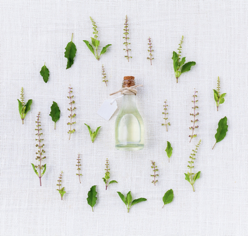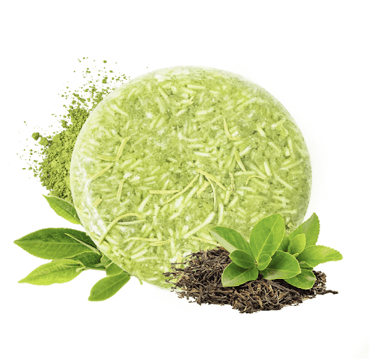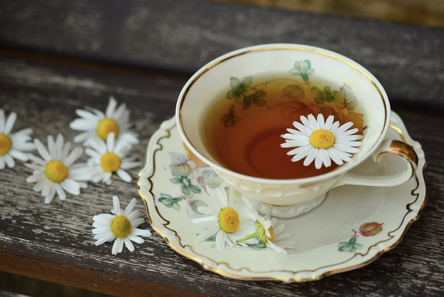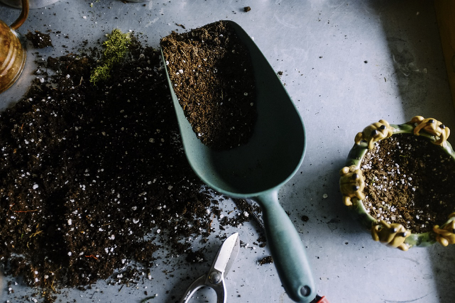How will growing herbs be beneficial for you?
- Herbs often have very specific strong scents, which is why they are very effective at misleading pests. The smell of the herb dominates for pests, they get confused and find food difficult or impossible. This is an important principle of our ‘Apparent Chaos’ which is a combination system and is actually an indispensable part. Insects search primarily for odor hence, herbs are ideal distractors.
- Insects such as bees, butterflies, flies, bumble bees, etc. are often fans of the herb blooms and come in large numbers. Attracting these pollinators, on the other hand, has advantages for different fruits and vegetables and leads to higher yield.
- Herbs are often annual, so they only need some – or even no – pruning after the winter. Several annual plants are also perennial plants that sow themselves again and again every year and thus become a fixed value in the garden.

Seven Herbs That You Can Grow Easily:
1.Basil
Basil is a plant that measures 20 to 60 cm high and has oval-lanceolate leaves, reaching 2 to 3 cm, pale green to dark green in color, sometimes purple. However, it can easily reach more than a meter in length when kept for several years.
The properties of basil are mainly antibacterial, antispasmodic and invigorating. The essential oils of basil relieve respiratory tract infections; hair acne problems as well as intestinal bloating. Its toning action is also beneficial for hair care.
2. Lemongrass
Also known as verbena from India (or Indian), or lemongrass, is a perennial herb with large blades up to 3 metres high. Research has shown that lemongrass has antifungal and antibacterial properties. These abilities can be important in the fight against hair loss resulting from inflammation, a secondary issue caused by genetics.
3. Mint
Although mint is rarely found in shampoos, it is easier to find mint in shampoo bars. Again, it is its refreshing properties that are prized: menthol refreshes the scalp, thus limiting itching, after shampooing, in addition to leaving a very pleasant fragrance on your hair. Apparently, crushing mint leaves is a bad idea. Firstly, It wouldn’t have the same effect, and secondly you’d look funny with pieces of green leaves in your hair.

4. Cilantro
Cilantro is one of the most effective spices for improving the health and growth of your hair. Include it in your diet in the form of leaves or seeds.
You can also add Cilantro seed powder to your hair oil and massage your scalp with it to give you the best results by significantly stimulating the hair follicles.
5. Rosemary
You can freshly brew your own rosemary tea by boiling the rosemary leaves over low heat in the water. Or just include it in your daily diet.
Washing your hair with this infusion can also help you get rid of dandruff, which is considered to be one of the main factors in hair loss.
6. Lavender
Lavender is the natural treatment for damaged hair, eliminating dandruff, preventing hair loss and reducing split ends. In addition, people with unwanted lice or unwanted nits will certainly benefit and make full use of lavender shampoo bars. Apart from that, this can be applied when someone is really struggling with hair loss. In order to grow your hair, just do a gentle wash of your hair with a lavender shampoo bar. You can actually see and feel the result immediately!
7. Chamomile
Chamomile is a completely natural alternative to relieve various health problems without using chemicals. We can take advantage of it in infusion or topically.
Use chamomile tea to rinse your hair after washing it with your shampoo. This will promote hair growth. Chamomile relaxes the hair fibers and the scalp while reducing hair loss.

Helpful Growing Tips:
Here are 4 tips that will motivate you to grow herbs in your garden:
- Start Small: In general, people tend to get carried away when they start planning their very first herb garden. Since you don’t have much space, you can choose one or two easy-to-grow herbs.
- Organize Your Balcony: When you run out of space, you have to be imaginative. Do not hesitate to create space in height to grow different plants. You can make your own raised herb garden yourself so that it fits the space available. You will also find in many stores above ground gardens in wood or plastics, which are perfect for herb growing.
- Choose Good Pots: Go to the garden center to get your plastic pots. You will find something for everyone! Choose pots with drainage holes. These holes are used to evacuate water and avoid drowning the roots. Before using your pots, they must be washed and disinfected.
- Use Good Soil: You will need specialized soil for growing in pots or planters. In this type of container, the soil tends to dry out faster; this is why it is important to opt for a quality peat-based soil that will retain more moisture. The maintenance of the herb garden in pots comes down to moderate but regular watering in order to avoid drying out.
How To Grow These Indoors?
For beginners, it can also serve as a low-stakes entry into more substantial herb gardening. Whenever you need some, clip a few sprigs to use in a recipe or as a pretty garnish. But before you pot up your first plant, ensure your success by following these surefire strategies.

1. Pick The Right Plants
Most herbs can be grown indoors, but those that tend to thrive inside include no-fuss picks like basil, chives, mint, oregano, parsley, rosemary and thyme. You can start herbs from seed or cuttings (a branch of an existing plant cut at the node and soaked in water until new roots sprout), but will find it much easier-and faster-to begin with seedlings from the garden center.
2. Select a Container with Drainage
You can plant herbs in virtually any container, so long as it has some type of drainage and something to protect the surface underneath, such as a saucer or round plastic protector (available at garden centers). If you are using nontraditional planters such as mason jars, place a layer of pebbles in the bottom to catch excess moisture. You can use any size container you like provided the plant fits, but realize that the smaller the vessel, the sooner you’ll have to repot.
3. Choose the Sunniest Spot
Your indoor herb garden will need at least six hours of sunlight per day to thrive. Place plants as close as possible to your brightest window. Avoid setting them in the center of a room or near a window with a northern exposure, neither of which will offer enough light. Growth may be slow and laggy during winter months; consider investing in a grow light or waiting until spring.
4. Water-But Not Too Much
You’ll be surprised by how little water it takes to sustain a small herb. Keep soil consistently moist, but not waterlogged. A small watering can or a drizzle under the sink will suffice. If the leaves begin to wilt or turn yellow, scale back the H20.
5. Harvest Little At A Time
Harvest a few sprigs with kitchen shears or by pinching leaves off with your fingers. Bonus: Regular cutbacks encourage new growth. Avoid removing more than a quarter of the plant at a time, which will cause distress and could even kill the plant.
6. Transplant When Ready
Indoor herb plants are not forever. The good/bad news is that if you do it right, your herbs will eventually outgrow their containers and need more space. If you see roots coming out of the drainage holes, growth seems to have stalled or the plant starts to flop over, it’s time to transplant.

In most climates, perennial herbs such as lavender and mint can be started inside and moved into the ground after the threat of frost has passed.
Annual herbs can be moved outdoors through the end of the growing season. When cold weather approaches, you can either bring the pots back indoors or leave them outside, but be sure to take cuttings before the first frost so you can start the whole indoor herb garden process over again.
Both annuals and perennials can be moved into larger pots within your home at any time; just keep them close to a light source.
